king and barons
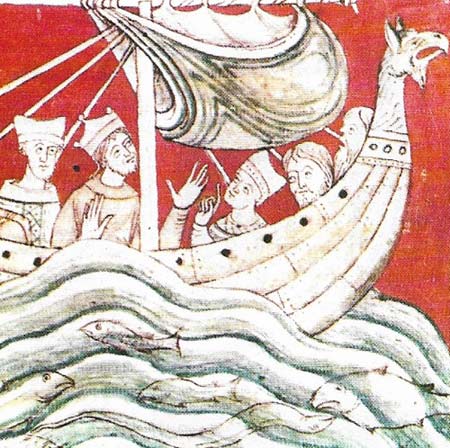
Figure 1. Henry II crossed to England from France in 1153, as this contemporary miniature shows. By 1150 it was clear that King Stephen could not eject the Empress Matilda or her son Henry from Normandy, nor could they expel the king from England. Henry's invasion threatened another bloody stalemate, but Stephen was made to disinherit his son Henry II and his magnates cooperated in restoring order, devising a more just and effective law, and introducing trial by jury and assize courts. These courts, which relied on travelling judges dispensing royal justice, impugned to some extent on the barons' rights to hold feudal courts on their own estates.
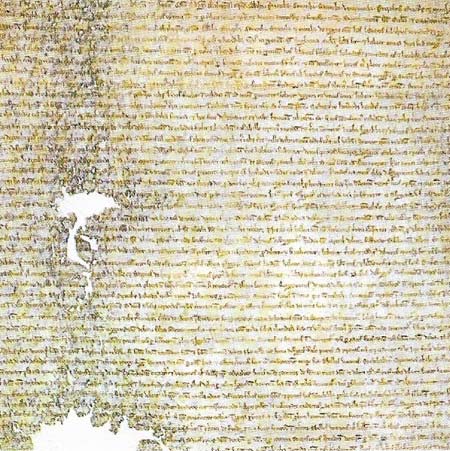
Figure 2. A copy of Magna Carta (one of only four official copies to survive) symbolizes the acknowledgment of the fact that the monarchy is subject to the law of the land. This recognition was extracted from an unwilling King John at Runnymede by a league of barons, churchmen, and townspeople. Magna Carta is a detailed schedule of specific articles that guaranteed many kinds of inherited rights and privileges and limited the king's prerogatives.
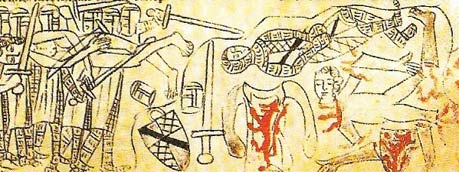
Figure 3. The Battle of Evesham (1265), which ended the "Barons' Wars", saw the defeat and death of Simon de Montfort. Despite this, his reforms of government, which reflected the growing authority of the classes below the baronial one, were largely accepted.
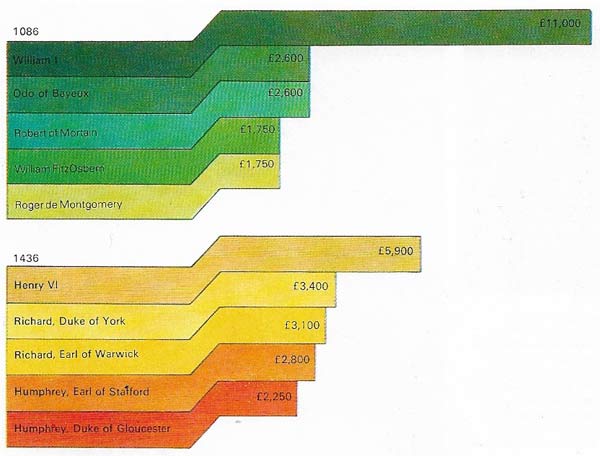
Figure 4. The king's income in 1086 and 1436, compared well with that of noblemen for the same period. The king's land in 1436 was mostly Lancaster (i.e. private) estates but his income was greatly boosted by taxes and customs (which are not shown here). By 1436 the king's advantage in landed wealth had obviously diminished.

Figure 5. The Court of King's Bench in about 1250 administered laws and functioned by means of already established procedure. The judges, clerks, and attorneys were all professional lawyers. The court was one of the most valuable institutions to the Crown in terms of prestige in the country and income from fines.
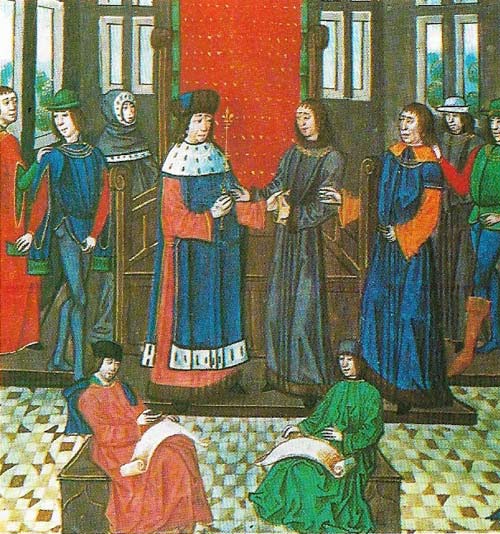
Figure 6. Richard II handed over his scepter when challenged by his exiled cousin, Henry Bolingbroke (Henry IV). The unreliable Richard had made too many of his subjects feel insecure to attract their permanent loyalty.

Figure 7. The nightmare of Henry I was narrated in an illustrated 12th-century chronicle by John of Worcester. According to this, Henry dreamed that he was confronted first with a mob of infuriated peasants, then with a group of armed knights brandishing their swords, and finally with a group of aggrieved prelates. The dream symbolizes the contemporary idea that society was divided, as King Alfred said, into "Men who fight, men who work, and men who pray". Henry's exhortations from the propertied classes had given him a reputation as a rapacious ruler. He also encouraged centralization of power, a concept that aroused opposition from the entrenched nobles and their followers.
The institutions of English government were born between 1100 and 1400; only the monarchy itself is older. Kings before Henry I had taxed and dispensed justice, but the permanent institutions of the Exchequer and the King's Court on Justice took shape in his reign. They were the foundations of the vast structure of government that developed in the twelfth century: the Chancery, the Privy Seal, the courts of King's Bench, and Common Pleas. The workings of this great machine penetrated into every corner of the kingdom, and its powers and limits were the underlying political question of the age.
The growth of the leading families
Naturally, those with most to gain or lose from the king's government were his greatest subjects, whom medieval chronicles and documents such as Magna Carta call the "barons". During the 12th century, the English nobility constituted a formidable order. Until then, the members of great noble families had been adventurers, and few survived more than two generations. From Henry I's reign onwards the natural life of a baronial family was much longer, as political cooperation and the development of landed estates became more attractive.
In defence of the principle of inheritance, the families made a determined front, and subsequent kings could not ignore the power and the steadily accumulating wealth of successive generations of Lacys, Clares, Bigods and Mortimers. Far from being opponents of central government, they usually wished to participate in it, and the "common law" administered in the king's courts, with its sensitivity to questions of land and inheritance, was developed to meet their needs.
The12th century was the period of formation for both the baronage and the king's government. Henry I (reigned 1100–1135) (Figure 7) raised many new families from obscurity, which threatened old-established barons, but it was reasonably possible in his reign for a landed family to hold on to its property and to prosper. But the civil wars of Stephen's reign (1135–1154) (Figure 1), which followed Henry's death, was the critical time for all landed families, old or new. The succession dispute, far from providing opportunities for them, made their tenures radically insecure. The Treaty of Winchester (1153), which assured the succession of Henry II, also ensured the survival of the great landed estates, and most of the barons gave Henry their loyal support in return for the profitable "incidents" (wardships, or marriage to heiresses in the king's protection) or offices (such as the shrievalty of a county) created by renewed royal power.
Magna Carta and after
The loss of the European dominions by King John (reigned 1199–1216), and his attempt to regain them forced him to exploit his authority and patronage, and "amerce" or take a fine from the barons for every favor he did them and every real or imagined offence he "overlooked".
 |
| The Great Seal of King John (c. 1210) symbolized the beginnings of a momentous change in methods of government. In John's reign the Chancery formalized its procedure and began to keep systematic records of the grants and royal acts made under the Great Seal. The two series of Patent Rolls (open letters) and Close Rolls (written to individuals) show the birth of a professional civil service with its own interests. |
Many were brought to the point of ruin. The inevitable reaction resulted in Magna Carta (1215) (Figure 2), in which the barons tried to enumerate and forbid the various abuses of royal power. Its reassertion of fundamental rights was not a revolutionary idea, but it marked the resumption of the leadership of the community, by the united baronage.
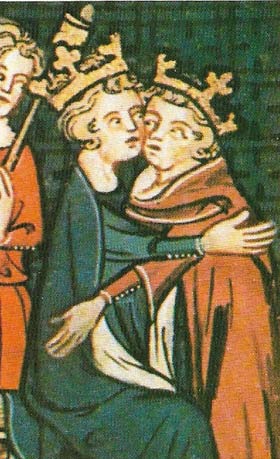 |
| John gives he traditional kiss of peace to Philip II Augustus, King of France (r. 1180–1223), his feudal superior. John, who, as the brother of Richard (r. 1189–1199), had occasionally been an accomplice of Richard's enemy, King Philip, was far less successful at holding together the Angevin Empire than Richard. By 1204, the French king's armies had swept through the fortresses of Normandy; the attempt to regain them put a strain on English resources until the Treaty of Paris in 1259. The loss of Normandy brought to an end long wars in France, but in the subsequent recriminations it also had the effect of tarnishing John's image, and from then on he was regarded as an incompetent king. |
Most of the subsequent conflicts between king and barons were the result of the Plantagenets' foreign ambitions and the strain this put upon their subjects. In each case the barons acted merely as the spokesmen of a now entrenched and articulate landed class. The ambition of Henry III (reigned 1216–1272) to intervene in Italian politics led to a spirited contest with Simon de Montfort (c. 1208–1265) at the head of a strong popular movement. The baronial programme, enshrined in the Provisions of Oxford of 1258, put control of the administration into the joint hands of the king and the barons to prevent the Crown developing interests against those of the nobility and, by implication, those of the country. De Montfort's cause was finally overthrown (Figure 3), but he had sufficiently shown the impossibility of foreign wars without a broad consent.
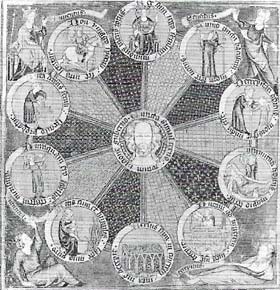 |
| The wheel of fortune was a popular symbol in the 1300s and 1400s. It testified to the preoccupation with the acquisition of wealth and advancement via patronage. Many medieval illustrations stressed the impermanence of authority, and new balances of power had constantly to be made. The opportunities open to able, ambitious but poor young men increased in the 1300s. Fortunes could be made from war, and time spent in the service of the king or a great nobleman could also be profitable. |
The barons and external wars
Edward I (reigned 1272–1307) was more masterful than his father, Henry III: but the strain put on the economy by his Scottish wars – taxation, the king's right to "purveyance" (seizure of supplies for his campaigns), and the hard military service – alienated his barons in the absence of decisive victory. They vented their frustration on his weaker son Edward II (reigned 1307–1327). At first only his favourite, Piers Gaveston (died 1312), was under attack, but the barons demanded in the "Ordinances" of 1311 control over the king's household and his powers of patronage.
Edward III (reigned 1327–1377), however, showed that confrontation could be avoided. He reconciled the baronial factions in the great national enterprise of the French wars and opened up for them prospects of new wealth at French expense, at a time of falling profits from land. Richard II (reigned 1377–1399) (Figure 6), because of his reliance on a private army and household government and Henry VI (reigned 1422–1461; 1470–1471), because of his insanity, were both driven from their thrones; but a fundamentally stronger national government came into existence in the fourteenth century through the combined efforts of kings and barons.
 |
| John of Gaunt (1340–1399), the greatest noble of the reigns of Edward III and Richard II, kept a small armed retinue even in peacetime; it derived from the army he collected for the wars in France. |
